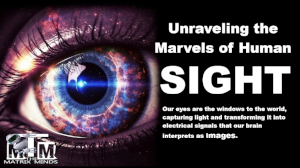
The human visual system is a complex and intricate mechanism that allows us to perceive the world around us in stunning detail. Our eyes are the windows to the world, capturing light and transforming it into electrical signals that our brain interprets as images. In this article, we will delve into the fascinating process of how vision works, from the moment light enters our eyes to the interpretation of these signals in the brain.
- The Anatomy of the Eye
The human eye is a highly specialized organ, designed to receive, focus, and transmit visual information to the brain. It consists of several key components, each with a crucial role in the visual process. The main structures include:
a. Cornea: The transparent, dome-shaped covering at the front of the eye, responsible for focusing incoming light.
b. Iris: The colored part of the eye, controlling the size of the pupil and regulating the amount of light that enters.
c. Pupil: The black, central opening of the iris that changes size to adjust for varying light conditions.
d. Lens: A flexible, crystalline structure behind the iris that further focuses the light onto the retina.
e. Retina: A delicate layer of tissue lining the back of the eye, containing millions of light-sensitive cells called photoreceptors.
- Light Capture and the Role of Photoreceptors
When light enters the eye through the cornea and pupil, it encounters the lens, which adjusts its shape to focus the light precisely onto the retina. The retina is where the magic happens, as it contains two types of photoreceptor cells: rods and cones.
a. Rods: These cells are highly sensitive to light and allow us to see in low-light conditions. They are primarily responsible for peripheral vision and detecting motion.
b. Cones: Cones are less sensitive to light but excel at detecting colors and finer details. There are three types of cones, each sensitive to different wavelengths, enabling us to perceive a wide range of colors.
- Signal Transmission in the Retina
The photoreceptor cells convert light into electrical signals, initiating the visual process. These signals then pass through a series of retinal layers before reaching the ganglion cells, the output neurons of the retina. The ganglion cells collect the information from the photoreceptors and send it to the brain through the optic nerve.
- The Optic Nerve and Visual Pathway
The optic nerve is a bundle of more than a million nerve fibers carrying the visual information from the retina to the brain. These nerve fibers exit the eye at the optic disc, creating a blind spot where there are no photoreceptors. Fortunately, our brains compensate for this blind spot, filling in the missing information based on the surrounding visual context.
- Visual Processing in the Brain
Upon reaching the brain, the visual information undergoes extensive processing. The primary visual cortex, located in the occipital lobe at the back of the brain, plays a fundamental role in basic visual processing. Here, the brain organizes the received signals and begins to identify shapes, colors, and orientations.
The processed information then travels to other regions of the brain responsible for higher-level visual functions, such as object recognition, face perception, and spatial awareness.
- Visual Perception and Interpretation
The brain’s complex neural networks allow us to perceive the world in intricate detail. It combines the information received from both eyes, giving us depth perception and a three-dimensional view of our environment. The brain’s ability to interpret visual cues enables us to recognize familiar objects, understand spatial relationships, and navigate our surroundings seamlessly.
The process of vision is an awe-inspiring collaboration between the eyes and the brain. From capturing light through the complex retinal system to the neural processing that leads to our perception of the world, the human visual system is a remarkable feat of biological engineering. Understanding how our eyes work and how the brain processes visual information not only deepens our appreciation for the wonders of nature but also helps us comprehend vision-related disorders and develop innovative approaches to vision care.
DIVING EVEN DEEPER
Vision Signals and Neural Coding
The process of vision involves the conversion of light signals into electrical impulses that the brain can interpret. This transformation of light into neural signals occurs at multiple stages within the visual system.
a. Phototransduction: In the retina, photoreceptor cells (rods and cones) contain specialized molecules called photopigments that react to light. When light strikes these photopigments, they undergo a chemical reaction, generating electrical signals. This process, known as phototransduction, converts light energy into electrical signals, which are then relayed to the next layers of the retina.
b. Neural Signaling: Once the electrical signals are generated in the photoreceptor cells, they pass through a network of interconnected neurons in the retina. The signals undergo complex processing, including lateral inhibition, which enhances the contrast and sharpens the edges of visual stimuli.
c. Receptive Fields: Different neurons in the visual pathway have specific receptive fields, meaning they respond preferentially to certain types of visual information. Some neurons are more sensitive to edges, while others are tuned to respond to specific orientations or directions of movement. This specialization allows the brain to extract different features from the visual scene efficiently.
Visual Processing in the Brain: Ventral and Dorsal Streams
Once the signals leave the retina and travel through the optic nerve, they are processed in the brain through two major streams: the ventral stream and the dorsal stream.
a. Ventral Stream: This pathway, also known as the “what” pathway, is responsible for identifying objects and recognizing their visual attributes. It processes information related to color, shape, and texture and allows us to recognize familiar objects and faces. The ventral stream is critical for our ability to identify and categorize the visual world.
b. Dorsal Stream: The dorsal stream, or the “where” pathway, is concerned with spatial processing and motion perception. It helps us understand the spatial relationships between objects and enables us to perceive motion and navigate our environment accurately.
These two streams work in parallel, allowing us to simultaneously identify objects and understand their spatial context, ultimately creating a unified and coherent visual experience.
Binocular Vision and Depth Perception
Binocular vision is a remarkable aspect of human vision, which refers to the ability to perceive the world using both eyes simultaneously. Having two eyes positioned slightly apart on the face provides us with overlapping fields of view, which allows the brain to merge the two slightly different images into one composite image. This process, known as binocular fusion, creates depth perception, enabling us to perceive distances and perceive the world in three dimensions.
Visual Illusions and Perception
The brain’s interpretation of visual signals is not always perfect, leading to intriguing phenomena like visual illusions. Illusions occur when the brain misinterprets or distorts visual information, resulting in perceptions that do not correspond with physical reality. These illusions offer valuable insights into how the brain processes visual signals and highlight the complex interplay between sensory input and cognitive processing.
Vision is an extraordinary sensory experience that involves a sophisticated interplay between the eyes and the brain. From the initial capture of light by photoreceptor cells to the neural processing and interpretation of visual signals in the brain, the journey of vision is a symphony of biological marvels. Understanding how our eyes and brain work together to perceive the world around us can lead to advancements in fields such as neuroscience, artificial intelligence, and vision restoration technologies. As we continue to unravel the complexities of vision, we gain a deeper appreciation for the intricacies of human perception and the wonders of the visual world.



Leave a Reply
Want to join the discussion?Feel free to contribute!